Papers by Enrico Di Stefano
Italian Journal of Geosciences, 2014
Quaternary Science Reviews, 2006
New faunal and floral records from Ocean Drilling Project Hole 963A, resolved at ∼80-year spacing... more New faunal and floral records from Ocean Drilling Project Hole 963A, resolved at ∼80-year spacing, provide evidence of suborbital scale climate variability in the central Mediterranean Sea throughout Marine Isotope Stage (MIS) 5. Cold events in the central Mediterranean Sea, indicated by low abundances of warm species and high abundances of cold species, are also evident in a planktonic foraminifera
Quaternary Science Reviews, 2012
Here we present a high-resolution faunal, floral and geochemical (stable isotopes and trace eleme... more Here we present a high-resolution faunal, floral and geochemical (stable isotopes and trace elements) record from the sediments of Ocean Drilling Program Site 963 (central Mediterranean basin), which shows centennial/millennial-scale resemblance to the high-northern latitude rapid temperature fluctuations documented in the Greenland ice cores between 20 and 70 kyr BP.
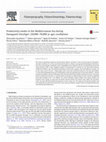
Palaeogeography, Palaeoclimatology, Palaeoecology, 2013
The study of planktonic organisms during abrupt climatic variations of the last glacial period (D... more The study of planktonic organisms during abrupt climatic variations of the last glacial period (Dansgaard-Oeschger oscillations, D-O) may reveal important insights on climatic, oceanographic and biological interactions. Here we present planktic foraminifera and coccolithophore data collected at the Ocean Drilling Program Site 963 (Sicily Channel), with a mean sampling resolution of respectively 43.5 and 98.9 yr, over the interval between 70,000 and 20,000 yr ago. The paleoenvironmental reconstruction suggests that three different scenarios can be seen across each D-O cycle: 1. oligotrophic surface water and a deep thermocline for the early Interstadials; 2. a Deep Chlorophyll Maximum and coccolithophore winter/spring blooming in the late Interstadials; 3. reduced productivity together with the shallowing of the nutricline depth during Stadials and Heinrich events. The unique mode of productivity dynamics is corroborated by comparing our paleoecological results with those published from high-resolution cores in the Alboran Sea clearly indicating reduced trophic levels during Stadials and Heinrich events. Finally, we argue that the density contrast between the Atlantic water inflow and subsurface water may have affected productivity dynamics in such a large area. The strong vertical density gradient may have hampered the vertical convection of the water column, producing a negative effect on biological productivity, especially during Stadial phases.
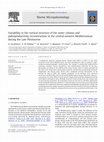
Marine Micropaleontology, 2008
A sedimentary sequence spanning Marine Isotope Stage (MIS) 6 to MIS 2 in core LC07, recovered in ... more A sedimentary sequence spanning Marine Isotope Stage (MIS) 6 to MIS 2 in core LC07, recovered in the central Mediterranean, has been investigated in order to produce a highresolution paleoceanographic reconstruction. The changes in productivity deduced from calcareous plankton relative abundances and independently confirmed by the Ba XS fluctuations are linked to the stability of the water column which is mainly controlled by the water mass temperature. During glacial intervals, productivity was generally enhanced. Oligotrophic and warmer water masses with a deepened seasonal thermocline can be inferred for most of MIS5. The magnetic properties of the sediment show increased occurrences of North Africa dust in the central Mediterranean during cold phases, likely as a consequence of a more efficient erosive process triggered by southward displacement of the intertropical convergence zone. Although increases in both productivity and Saharan dust occurred during cold periods, the atmospheric inputs do not seem to contribute significantly to the fertilization of primary producers. A Shannon Index curve has been used to tentatively synthesize the variations of calcareous nannofossil assemblages through the last 150 kyr. The assemblage diversity sharply increased coincident with the transition from the penultimate glacial to the last interglacial, subsequently low diversity was gradually reached again in the last glacial.
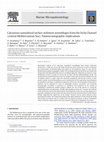
Marine Micropaleontology, 2008
Quantitative analysis of 67 calcareous nannofossil assemblages from surface sediments recovered i... more Quantitative analysis of 67 calcareous nannofossil assemblages from surface sediments recovered in a wide area across the Sicily Channel has been carried out in order to improve the interpretation of palaeontological data based on this planktonic group in a key area for Mediterranean palaeoceanographic studies. The investigation focused on three case studies that demonstrate the high potentiality of such a combined approach, taking into account the recent distribution of taxa or groups of taxa on the sea floor and the palaeontological record. The distribution of reworked specimens over the northern Sicily Channel sea floor validates the role of southern Sicily as a source region for reworked nannofossils and the role of rivers as their carrier. Eustatic sea-level fluctuations can be considered to be the main factor that influenced the abundance variations in sedimentary sequences of this area. The distribution of Florisphaera profunda can be explained in terms of topography (positive correlation) and mesoscale oceanographic circulation. In particular, its significant anti-correlation to the amount of chlorophyll-A deduced by satellite imagery validates the use of this species as a proxy for palaeoproductivity reconstructions. Finally, high abundance values of G. oceanica are confined to the westernmost part of the Sicily Channel, coinciding with a water mass salinity minimum. In particular, abundances of up to about 10% were observed in the westernmost part of the African Margin, suggesting the importance of the Atlantic Tunisian Current, whose activity is more pronounced in winter. The comparison of data of this species between 135 and 110 kyr BP, inside and outside the Channel, led us to deduce that the physical transport in almost unmodified waters of Atlantic origin might be the most important factor for its significant occurrence.
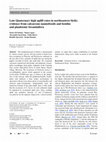
Facies
The northeastern part of Sicily is characterized by intense seismic activity. Several systems of ... more The northeastern part of Sicily is characterized by intense seismic activity. Several systems of faults have been recognized in Pliocene and Pleistocene sediments in the area and, in fact, estimates of uplift rates are among the highest recorded in Sicily and south Italy. We examined calcareous nannofossil and benthic and planktonic foraminifera assemblages from pelitic sediments of the Contrada Zura section (Barcellona Pozzo di Gotto Basin, Furnari village, Messina). The occurrence of Emiliania huxleyi, a coccolithophore species which appeared in the oceanic record about 270,000 years ago, is witness to the uniqueness of this outcrop, while the planktonic/benthic foraminifera ratio indicates a deep (slope) environment, in agreement with previous observations on macrobenthic and ostracod paleo-communities. Independently from the numerical estimate of the paleo-depth, there is little doubt that the occurrence of E. huxleyi in such sediments might be explained by exceptional uplift rates. Since resulting uplift rate estimates, between 3.2 and 5.5 mm/year, exceeded by far the regional, longer-term, vertical tectonic motion, we argue that a major contribution of coseismic displacement along active faults occurred in the Furnari area.
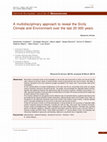
Central European Journal of Geosciences, 2010
We present a thorough review of the knowledge on the climate and environment in Sicily over the l... more We present a thorough review of the knowledge on the climate and environment in Sicily over the last 20 000 years, taking into account results of several studies carried using terrestrial and marine records. We obtain a coherent framework of the most important changes succeeded in the island, even if some points need further investigation. All the reconstructions of surface temperatures of the seas and the air surrounding Sicily point out severe climatic conditions during the last glacial period. The steppe- and semisteppe-like vegetation pattern testifies, together with additional evidence from geochemical data of lacustrine evidence, markedly arid conditions. Fi-nally, significant episodes of sea level drop connected Sicily to the Italian Peninsula and favoured the dispersion of faunal elements from southern Italy. The transition between the last glacial and the Holocene was not characterized by a gradual warming but was punctuated by two abrupt suborbital climatic fluctuations: Bølling-Allerød (warm) and Younger Dryas (cold), as recognized in the sediments recovered close to the northern and southern coast of Sicily. A denser arboreal cover is possibly indicated by the occurrence of dormouse and Arvicola remains. Finally the sensitivity of Sicily to climate perturbations is demonstrated by the occurrence of repeated subtle climatic anomalies during the Holocene, including the Little Ice Age, also known from historical chronicles. Forests, woods and Mediterranean maquis developed in the early-middle Holocene. Thereafter was a general decline of arboreal vegetation, following a general aridification trend that seems to be a common feature in southern Europe and North Africa. Science Greek colonization (7th century before Christ), the landscape was intensively modelled for agriculture and breeding, leading to a significant loss of vegetation cover.
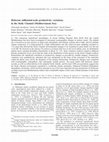
Paleoceanography, 2008
1] The calcareous nannofossil assemblages of Ocean Drilling Program Hole 963D from the central Me... more 1] The calcareous nannofossil assemblages of Ocean Drilling Program Hole 963D from the central Mediterranean Sea have been investigated to document oceanographic changes in surface waters. The studied site is located in an area sensitive to large-scale atmospheric and climatic systems and to high-and low-latitude climate connection. It is characterized by a high sedimentation rate (the achieved mean sampling resolution is <70 years) that allowed the Sicily Channel environmental changes to be examined in great detail over the last 12 ka BP. We focused on the species Florisphaera profunda that lives in the lower photic zone. Its distribution pattern shows repeated abundance fluctuations of about 10-15%. Such variations could be related to different primary production levels, given that the study of the distribution of this species on the Sicily Channel seafloor demonstrates the significant correlation to productivity changes as provided by satellite imagery. Productivity variations were quantitatively estimated and were interpreted on the basis of the relocation of the nutricline within the photic zone, led by the dynamics of the summer thermocline. Productivity changes were compared with oceanographic, atmospheric, and cosmogenic nuclide proxies. The good match with Holocene master records, as with ice-rafted detritus in the subpolar North Atlantic, and the near-1500-year periodicity suggest that the Sicily Channel environment responded to worldwide climate anomalies. Enhanced Northern Hemisphere atmospheric circulation, which has been reported as one of the most important forcing mechanisms for Holocene coolings in previous Mediterranean studies, had a remarkable impact on the water column dynamics of the Sicily Channel.








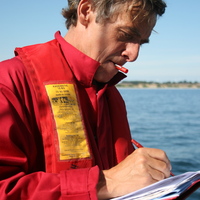

Uploads
Papers by Enrico Di Stefano